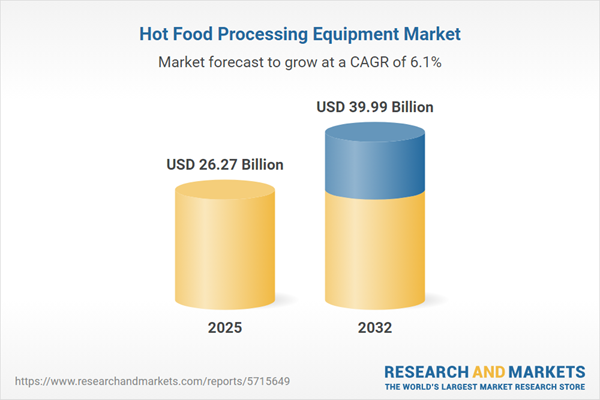Speak directly to the analyst to clarify any post sales queries you may have.
The hot food processing equipment market is evolving rapidly amid shifts in consumer preferences, regulatory demands, and ongoing advances in process automation and efficiency. Senior industry leaders face a complex landscape where operational resilience and adaptability are vital for growth and competitiveness.
Market Snapshot: Hot Food Processing Equipment
The hot food processing equipment market grew from USD 24.83 billion in 2024 to USD 26.27 billion in 2025 and is projected to reach USD 39.99 billion by 2032, representing a compound annual growth rate (CAGR) of 6.13%. Market momentum is fueled by surging demand for convenience foods, increased emphasis on safety standards, and a focus on energy efficiency across both global supply chains and regional markets.
Scope & Segmentation
This report provides a detailed segmentation and analysis across the hot food processing equipment landscape:
- Equipment Type: Blanchers, Breading & Coating Machinery, Fryers, Grills, Ovens, Steamers.
- Process Type: Baking, Blanching, Dehydration, Frying, Pasteurization, Roasting & Grilling.
- Technology: Batch Processing, Continuous Cooking.
- Automation Level: Fully Automated, Manual, Semi Automated.
- Heat Source: Electric, Gas.
- End User: Food Processing Industries, Food Service Industry, Household.
- Distribution Channel: Direct Sales, Distributors, Online Sales.
Global coverage spans the Americas, Europe, Middle East, Africa, and Asia-Pacific. Specific country-level analysis is included for key regions such as North America (United States, Canada, Mexico), Latin America (Brazil, Argentina, Chile, Colombia, Peru), Europe (United Kingdom, Germany, France, Russia, Italy, Spain, Netherlands, Sweden, Poland, Switzerland), Middle East (United Arab Emirates, Saudi Arabia, Qatar, Turkey, Israel), Africa (South Africa, Nigeria, Egypt, Kenya), and Asia-Pacific (China, India, Japan, Australia, South Korea, Indonesia, Thailand, Malaysia, Singapore, Taiwan).
Company trends and recent developments are assessed for major manufacturers including: GEA Group AG, Alfa Laval AB, Krones AG, JBT Corporation, Bühler AG, Alto-Shaam Inc., Amica Group, Breville Group, Electrolux AB, Godrej & Boyce Mfg. Co. Ltd., Haier Group, Hamilton Beach Brands Inc., Hisense International Co., Ltd., Illinois Tool Works Inc., LG Electronics Inc., Midea Group Co. Ltd., Miele & Cie KG, Panasonic Holdings Corporation, Robert Bosch GmbH, Samsung Electronics Co., Ltd., Sharp Corporation, SMEG S.p.A., Sub-Zero Group Inc., Toshiba Lifestyle Products and Services Corporation, and Whirlpool Corporation.
Key Takeaways for Decision-Makers
- Growth is powered by heightened consumer demand for convenience foods and increased focus on food safety and resource efficiency.
- Automation, integrated analytics, and modular design are now essential for optimizing productivity and supporting flexible operations.
- Sustainability is a dominant procurement driver, influencing investment in energy-efficient, low-emission, and waste-reducing technologies throughout processing plants.
- Customization and adaptability are essential, with modular systems enabling rapid response to emerging product trends such as plant-based and hybrid foods.
- Regional variations in regulatory requirements and power infrastructure shape operator strategies, driving adoption patterns for heat source types and automation levels.
- Strategic partnerships, local manufacturing, and expanded service networks are becoming central to build supply chain resilience and fast-track innovation for global equipment providers.
Tariff Impact on Market Dynamics
Recent United States tariffs on imported steel, aluminum, and specialized components have increased input costs and affected sourcing decisions for original equipment manufacturers (OEMs). Producers are mitigating such challenges through partnerships with domestic fabricators, diversifying supply chains, and localized manufacturing expansions. These shifts are influencing end-user decisions, equipment procurement models, and investment planning by food processors and service operators across value chains.
Methodology & Data Sources
The research utilizes comprehensive primary interviews with manufacturers, facility executives, and industry experts, supplemented by in-depth reviews of journals, regulatory filings, and technical papers. Data triangulation and rigorous cross-verification ensure substantive, actionable insights on technology adoption, supply chain patterns, and market segmentation.
Why This Report Matters
- Enables strategic investment by mapping out dynamic market drivers and segment-level opportunities across global regions.
- Delivers actionable intelligence on technology, regulation, and competitive positioning for informed decision-making and risk mitigation.
- Supports business planning with clear insights into sustainability trends and supply chain adaptation strategies.
Conclusion
The hot food processing equipment market is undergoing significant transformation shaped by innovation, sustainability priorities, and evolving regional landscapes. Decision-makers equipped with timely and targeted insights will seize competitive advantage and advance their organization’s position in this dynamic sector.
Additional Product Information:
- Purchase of this report includes 1 year online access with quarterly updates.
- This report can be updated on request. Please contact our Customer Experience team using the Ask a Question widget on our website.
Table of Contents
3. Executive Summary
4. Market Overview
7. Cumulative Impact of Artificial Intelligence 2025
Companies Mentioned
The companies profiled in this Hot Food Processing Equipment market report include:- GEA Group AG
- Alfa Laval AB
- Krones AG
- JBT Corporation
- Bühler AG
- Alto-Shaam Inc.
- Amica Group
- Breville Group
- Electrolux AB
- Godrej & Boyce Mfg. Co. Ltd.
- Haier Group
- Hamilton Beach Brands, Inc.
- Hisense International Co., Ltd.
- Illinois Tool Works Inc.
- LG Electronics Inc.
- Midea Group Co. Ltd.
- Miele & Cie KG
- Panasonic Holdings Corporation
- Robert Bosch GmbH
- Samsung Electronics Co., Ltd.
- Sharp Corporation
- SMEG S.p.A.
- Sub-Zero Group, Inc.
- Toshiba Lifestyle Products and Services Corporation
- Whirlpool Corporation
Table Information
| Report Attribute | Details |
|---|---|
| No. of Pages | 181 |
| Published | October 2025 |
| Forecast Period | 2025 - 2032 |
| Estimated Market Value ( USD | $ 26.27 Billion |
| Forecasted Market Value ( USD | $ 39.99 Billion |
| Compound Annual Growth Rate | 6.1% |
| Regions Covered | Global |
| No. of Companies Mentioned | 26 |









